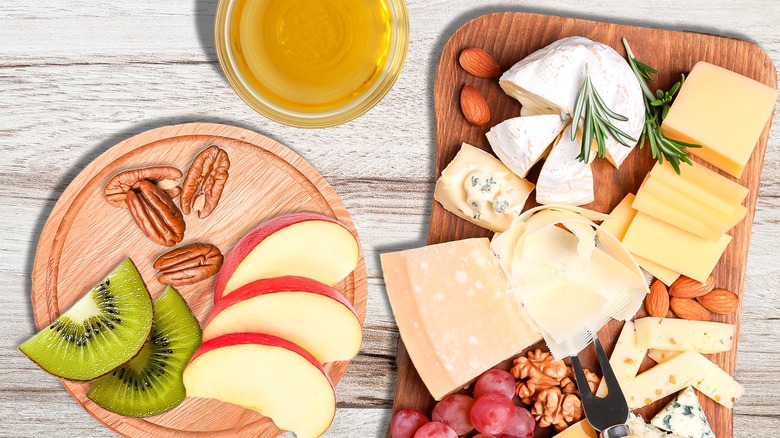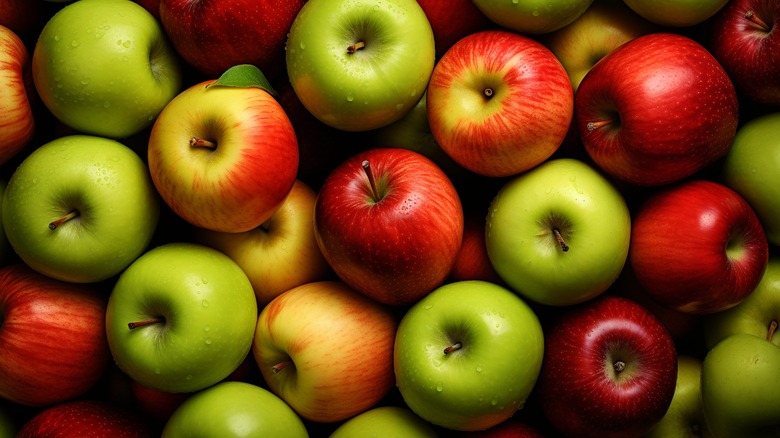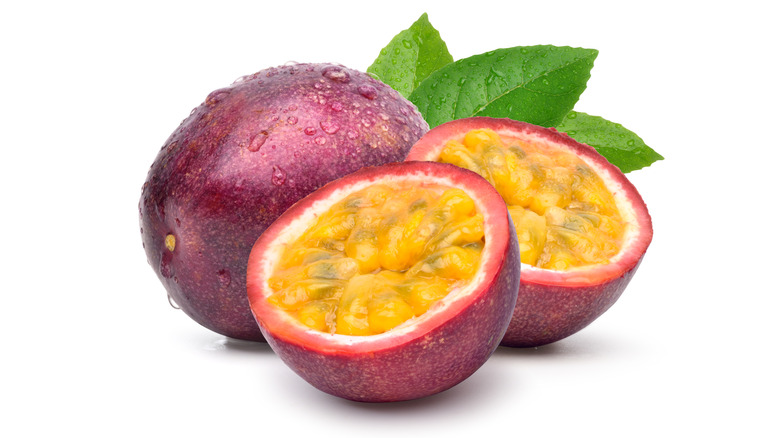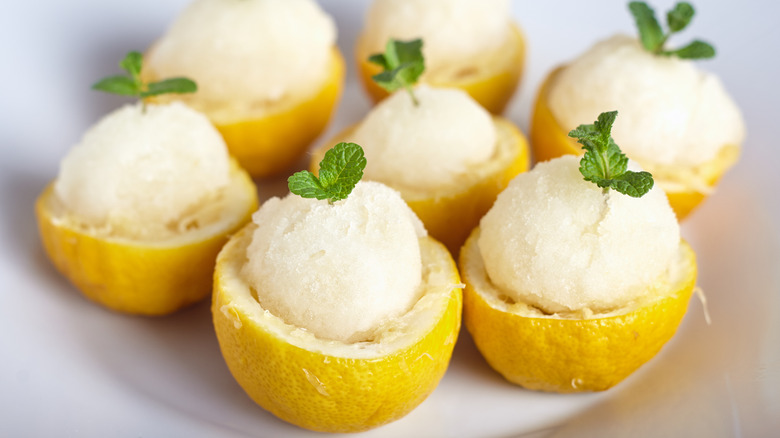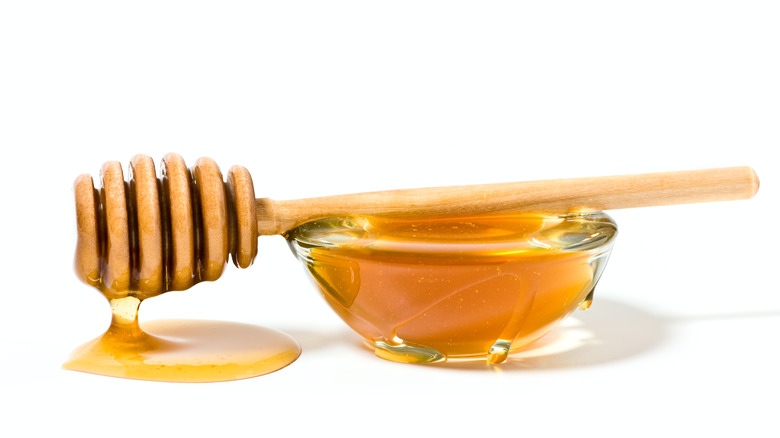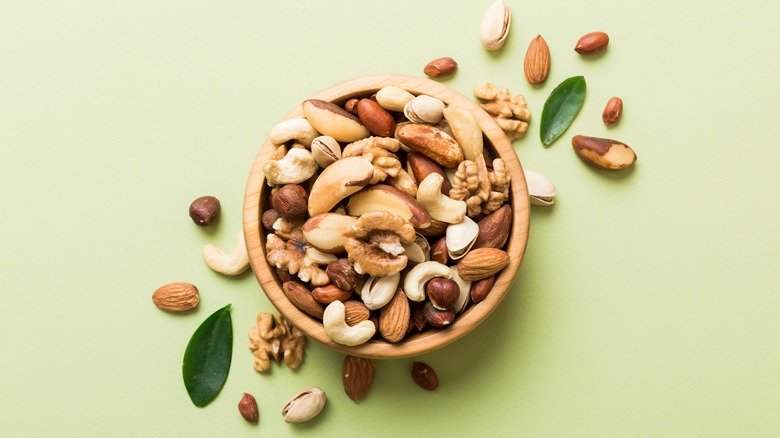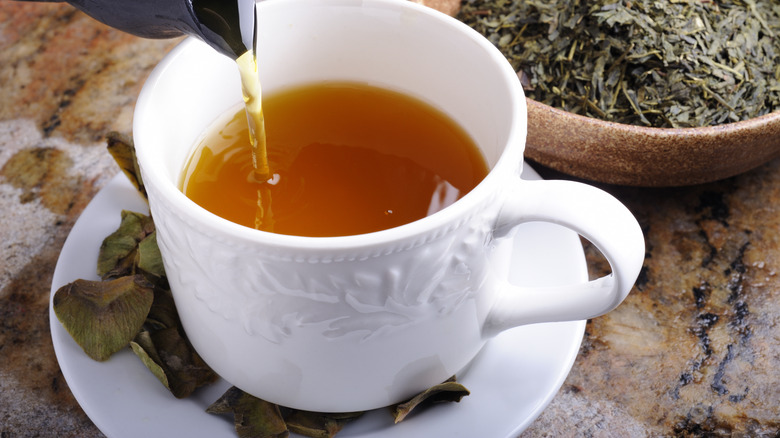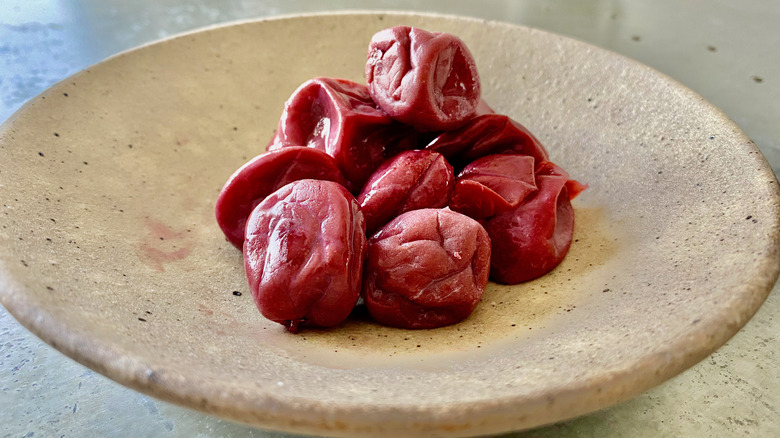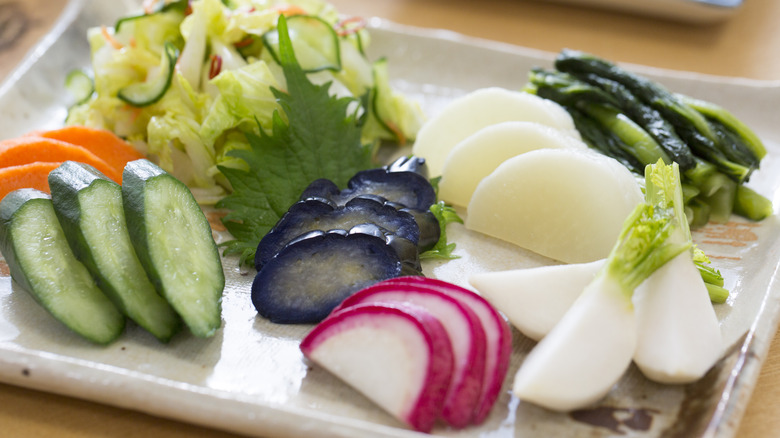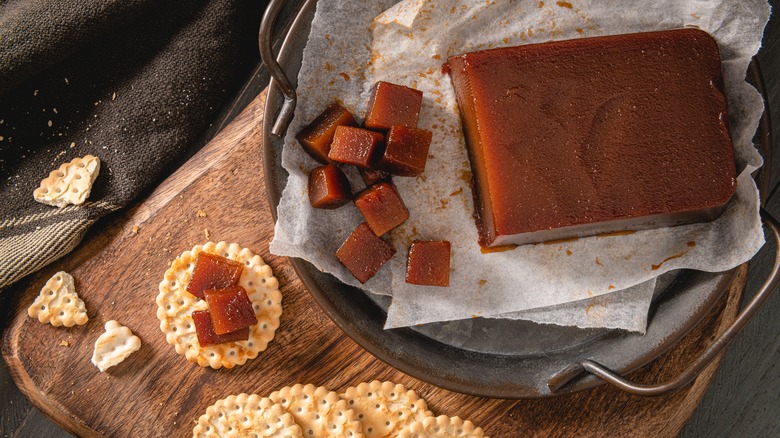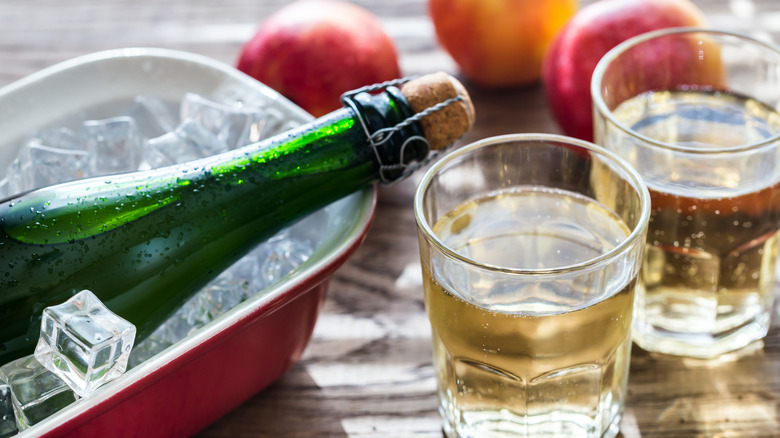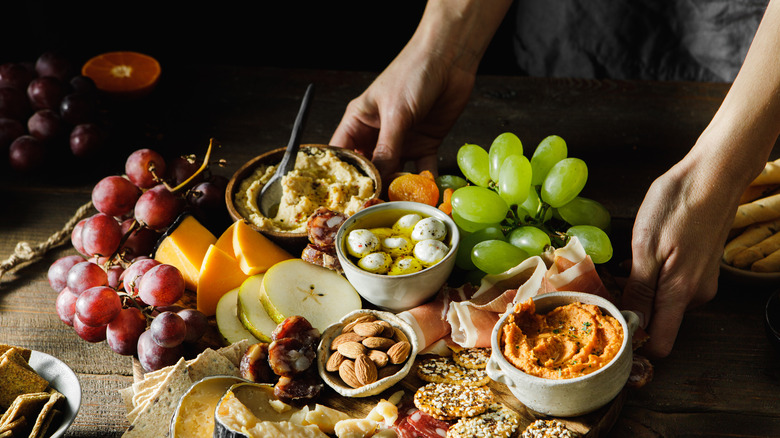The Absolute Best Palate Cleansers For Cheese Boards
Cheese boards are a wonderful way to explore a variety of cheeses, including styles, textures, flavors, and origins. Cheese boards make a fantastic way to entertain guests at any time of year, or just treat yourself to a no-cook snack, grazing meal, or after-dinner treat. While some would have us believe that more equals more when it comes to over-the-top platters and boards, a well-curated cheese board with a few paired-back, carefully chosen items including cheese and accompaniments, is much more impressive in our book, and can also be much more enjoyable for guests.
Jean-Baptiste Beroud, co-founder of 'Cheese, the Magazine of Culture' reminds us to consider non-cheese items as accompaniments to give your palate a little break. He says, "The way a cheese board should work is that you work your way around the board, from lightest to strongest, and therefore not needing a break. The board should also be built to complement and work together so you can 'work your way around.'"
Below are some well-placed pairing suggestions that can work in various ways to enhance your next cheese-eating experience. Recommendations are courtesy of Beroud, Dr. Anna Sulan Masing, co-founder and editor-in-chief of "Cheese, the Magazine of Culture," and Apoorva Sripathi, co-founder and editor of the dairy-loving magazine.
Apples
"Traditionally, apples are used as a palate cleanser," says Sripathi. Apples are also used as palate cleaners or refreshers during wine tastings, as their crisp, clean taste is very effective. Sripathi also suggests pears could have an effect here, as they share similar characteristics of being fresh, juicy, and a bit acidic. However, you'll probably want to lean away from any overly-ripe pears to achieve the same affect as apples, as pears tend to become sweeter and more fragrant as they soften.
You could also consider building a cheese board that can serve a secondary purpose as a palate refresher for wine tasting by including cheese, apples, pears, and other foods like olives and crackers are also known to refresh the palate when introduced in between sips. If you're concerned about browning, adding a small squeeze of citrus to your apple slices will help reduce the rate of discoloration while also providing an extra source of acidity to help refresh your palate and leave you ready for your next mouthful of cheese, wine or both.
Looking for a different way to include apples? Keep scrolling for one of Masing's favorite drink pairings that celebrate this seasonal, crisp fruit.
Sour fruits like kiwi and passion fruit
For those looking to add a pop of color to their cheese board, consider a range of tropical fruits like kiwi, passion fruit, pineapple, or even small but mighty pomegranate seeds. Not only will these fruits add visual intrigue, but they'll also help provide a short break for your palate and leave you wanting more — more cheese, that is.
Sripathi recommends juicy, sour fruits like kiwi and passion fruit for a burst of flavor with acidity that will cut through the cheese's fat, leaving your mouth refreshed. Other juicy and fresh fruits like watermelon would work well here, too, she suggests. It's no wonder salads like salty feta cheese and juicy, sweet watermelon are so satisfying — the flavors complement each other perfectly.
Some sour fruits, like pineapple, contain a protein-digesting enzyme known as bromelain. While sometimes this can affect the tongue by creating a burning sensation, sour fruits containing bromelain have also been known for their use as digestive aids, making a naturally occurring dual purpose to adding a few of your sour fruit favorites to your next cheese board.
Sorbet or frozen grapes
Not just a cool and refreshing treat on a hot summer's day, sorbets are a fantastic way to revive the tastebuds and your spirit. Unlike ice cream, this dairy-free, frozen treat, often made from sharp-tasting fruits like lemons, limes, grapefruit, green apple, or even herbs like fresh mint, won't leave a coating on your tongue. Sorbet is a traditional French palate cleanser between courses during a multi-course meal. However, for those who wish, a small serving of sorbet could also be used as a palate enlivener when serving a selection of rich cheeses.
Sripathi suggests a lemon or a lime-flavored sorbet. For those looking to serve their sorbet with a bit of extra flare and style, a lemon or lime sorbet served in their hollowed-out fruit, known as a givré, would make for a stunning presentation. Alternatively, Sripathi suggests frozen grapes, delivered in frosted bite-sized bursts, for a slightly more unusual but equally magical palate enlivener.
To avoid your next batch of frozen grapes from turning into one big clump, wash, pat dry, then, if available to you, consider freezing in a single layer to avoid them from sticking together. You could also add a dusting of salt, sugar, lemon, or lime juice to the grapes for an additional layer of flavor.
Honey
Dr. Masing recommends honey as an excellent accompaniment to cheese that can reflect something more about its origins. "When thinking of honey, it's good to think about location and season, as honey takes on the terroir, as does cheese. It can be nice to pair local honey with the local cheese," Masing explains. She suggests trying a Provence honey with floral notes of lavender paired with an Alpine Tomme, as an example.
With the hot honey trend in full swing, drizzling your store-bought or custom-made chili-rich honey over fresh, milky, soft cheeses like mozzarella, fresh ricotta, or burrata can add a new dimension to the cheese, so long as the heat of the chili isn't overpowering. Some have also argued that honey mustard is equally appreciated on a cheese board when paired with stronger cheeses like cheddar or creamy, rich varieties like Brie, Camembert, or Gruyère. Make sure that all honey-related pairings complement, rather than compete with, the flavors of your selected cheeses to achieve maximum balance and enjoyment.
Nuts
Nuts can make great accompaniments to a well-curated cheeseboard. Tree nuts like pistachios, almonds, and walnuts can often be found on cheese boards, especially the aesthetically pleasing, if not over-the-top versions that abound on social media. However, there's often little need for such overwhelming variety on a board, as this can lead to decision fatigue and bring down the overall satisfaction levels rather than achieving the desired alternative of maximum enjoyment. Like cheeses, consider limiting the type of nuts you offer to ensure they pair well with all the cheese offerings.
Nuts can be served as a savory or a sweet compliment, with options like candied pecans, herb-roasted almonds, or with a slight dusting of salt like pistachios. Equally, they can be served as it, allowing for their natural sweet and earthy flavors to shine through.
Masing suggests that nuts adding nuts as an accompaniment to your cheese board will help highlight and bring out the nuttiness of many kinds of cheese. They're also great for textural variety, adding something firm and crunchy to what can otherwise be quite a soft palate. When it comes to food, we often tend to forget about texture, which can be equally important for overall satisfaction.
Wine, sparkling wine, seltzer, or water
Sometimes, the best suggestions are the most obvious and the least complicated. Entertaining is the perfect opportunity to pull out a few of your favorite wedges and rinds and construct a cheese board. It also so happens to pair well with one of the first, almost instinctual gestures of welcome offered when hosting.
When welcoming guests into your home, offering a drink is a customary practice across many cultures, typically after greetings are exchanged and coats (and shoes) are removed. This will include warming cups of tea and coffee to custom-made cocktails, waters, or a glass of wine or beer. Drinks can also act as a precursor or gateway to the main event by warming up the palate and stomach, easing into the social event, and helping to set the mood for what is to come.
Beroud suggests that for those needing a pause in their cheese consumption, a simple sip of whatever wine or drink you have chosen to pair with the board is often the most effective when refreshing your palate. Water equally works well as a palate refresher during wine tastings.
Green or black teas
For those who wish to opt out of alcohol-led entertaining, tea can be a welcome alternative, with several varieties, flavor profiles, steeping practices, origins, and blends from which to choose. Whether selecting loose leaf or bags, caffeinated or herbal, there are often nuanced rituals and cultural customs that accompany the tea-making and serving process, from whom is served first to whether or not milk is added, to the types of cups, pots, and snacks used in the brewing and serving process. Teas can also be a fantastic accompaniment to a cheese board, offering balance and intervals of palate refreshment through their various flavor profiles.
"Acidity can also take the route of teas (they're mostly mildly acidic) so green or black to sip," says Sripathi. She suggests pairing a bloomy rind cheese, known for its young, sweet, and grassy flavors, with the floral notes of a rose green tea. Sripathi also recommends pairing Black Yeti oolong, known for its malty, amber, and caramel notes, with a rich, buttery, cheddar cheese for satisfying results that will leave tastebuds wanting more.
Pickled or marinated fruits like umeboshi
Pickled fruits are a fantastic and often underrated way to inject sweet-meets-sour notes into a cheese board, which will cut through the creamy fat of cheese and equally pair well with the nuttier, saltier cheeses.
For those looking to try something a bit out-of-the-box, Sripathi suggests pickled fruits, from Japanese picked plums known as umeboshi to pickled pears, which work well with many cheeses — including mild, grassy cheeses like a pecorino fresco. For those looking to savor the seasons, consider turning next summer's crop of peaches, tomatoes, or even fresh strawberries into a pickle that can be enjoyed year-round.
Sripathi also recommends incorporating spices into your next cheese board by making pickled fruits using mangos and pineapple, then marinating them with freshly squeezed lemon and a sprinkle of chaat masala. This intoxicating spice blend includes the powers of amchur, a distinctive sour-meets-fruity spice made from dried mango.
Pickled vegetables
Pickled vegetables are a mainstay in cuisines from around the globe, from kimchi to oshinko, a lightly salt-pickling technique used on vegetables in Japanese cuisine. That allows the vegetables to retain a pleasing crunch. While there are many different specific kinds of pickles in Japanese cuisine, tsukemono, which is the umbrella term for Japanese pickles, is present in most Japanese meals. Sripathi suggests using this as inspiration for your next cheese board accompaniment. "A bit unconventional... but tsukemono-style pickles that are a part of Japanese meals could also technically work here. I've used them in a sandwich with brie-style cheese, and pickled ginger works really well."
Pickled vegetables of all kinds can be a welcome treat on any cheese board, with pickle and cheese boards being a fantastic entertaining option. Add dilly beans, pickled okra, peppers, carrots, or items like Chicago-style Giardiniera to help revive the palate and leave tastebuds ready for the next bite of cheese. The combination of acidity from the pickle and varied textural crunch also adds hunger-stoking intrigue.
Fig and quince jams
While fruit jams and spreads can make for an excellent accompaniment to a cheeseboard, finding ones with a tangy, almost meaty texture, similar to pâté, can be a cut above the rest. Enter fruits like figs and quince, both of which Masing recommends incorporating into your next board.
Quince paste, also known as membrillo, makes for a fantastic pairing with nutty cheeses like manchego, each bringing out and highlighting the other's best characteristics. Quince paste is made by peeling, de-seeding, and cooking down the tangy fruit, originally from Southwestern Asia, with a mixture of sugar and water, then blending and chilling it down often into a rectangular form for ease of slicing thinly. The resulting color is a beautiful jewel-like red-orange, adding a rich pop of color to a board.
Like quince, fig jam can have the same meaty-like texture and slightly sweet-meets-tangy taste. Both quince and fig come with a somewhat earthy, funky undertone, making them a dream pick when paired with cheese, especially ones with similar undertones. While descriptions like 'funky' might not be appealing when describing many other foods, they are a thing of beauty when it comes to ferments, molds, and certain kinds of fruits.
Cider
Cider, as in the alcohol-based version made from apples, might be the dark horse in this list of cheese board accompaniments. Its presence is often unexpected, though Masing currently considers it her favorite contender when presenting drinks paired with selected cheeses.
Based in London, Masing recently co-hosted a cheese and cider pairing event, exploring the wide range of expertly crafted British cheeses with ciders. The event included ciders like Wading In paired with Dorstone goat's cheese from Neals Yard Dairy. Wilding Cider from Stoke Red in Somerset was paired with an earthy, mushroomy Tunworth from the Hampshire Cheese Company. The acidity of the ciders helped cut through the cheeses' richness while complimenting their flavors.
Cider doesn't get as much time in the spotlight as other alcohols like beer or wine; however, before the period of prohibition in the U.S., it was one of the most commonly consumed alcoholic beverages. The cider market's appeal and reach are rising and expanding within the U.S. and the U.K., making this a perfect cheese board accompaniment to take us from late fall into early winter and the festive season.
Add a wild card feature
We should preface this by saying that when adding a 'wild card,' it does pay to know the audience you're plating for, taking both tastes and allergies into consideration. Allergies and dietary restrictions are, of course, something to consider with all entertaining options. However, throwing something unexpected into the mix can be incredibly memorable for those who are open to new tasting experiences and pairings. Masing noted that one of her more memorable and fun cheese board pairings came by way of Turkish delight, accompanied by a slightly salty, crumbly cheese. Meanwhile, Sripathi loves a bit of bitter, dark chocolate when paired with more decadent cheeses — another unexpected yet memorable and enjoyable pairing.
The point both cheese-loving editors are making here is that, ultimately, the cheese boards are there to be enjoyed. It's ok and encouraged to be playful and thoughtful, as you incorporate selections and pairings that derive pleasure and spark curiosity from your palate and mind. Not sure what your wild card move should be? Try asking a local cheesemonger, favorite deli counter clerk, or get a hold of an issue of "Cheese, The Magazine of Culture" for a few suggestions alongside cheese inspiration to get you started.
